Lady and the Tramp
8.1 /10 2 Votes
89% Rotten Tomatoes Genre Animation, Adventure, Comedy Music director Oliver Wallace Country United States | 7.4/10 IMDb Producer Walt Disney Duration Language English | |||||||||||||||||||||||||||||||||
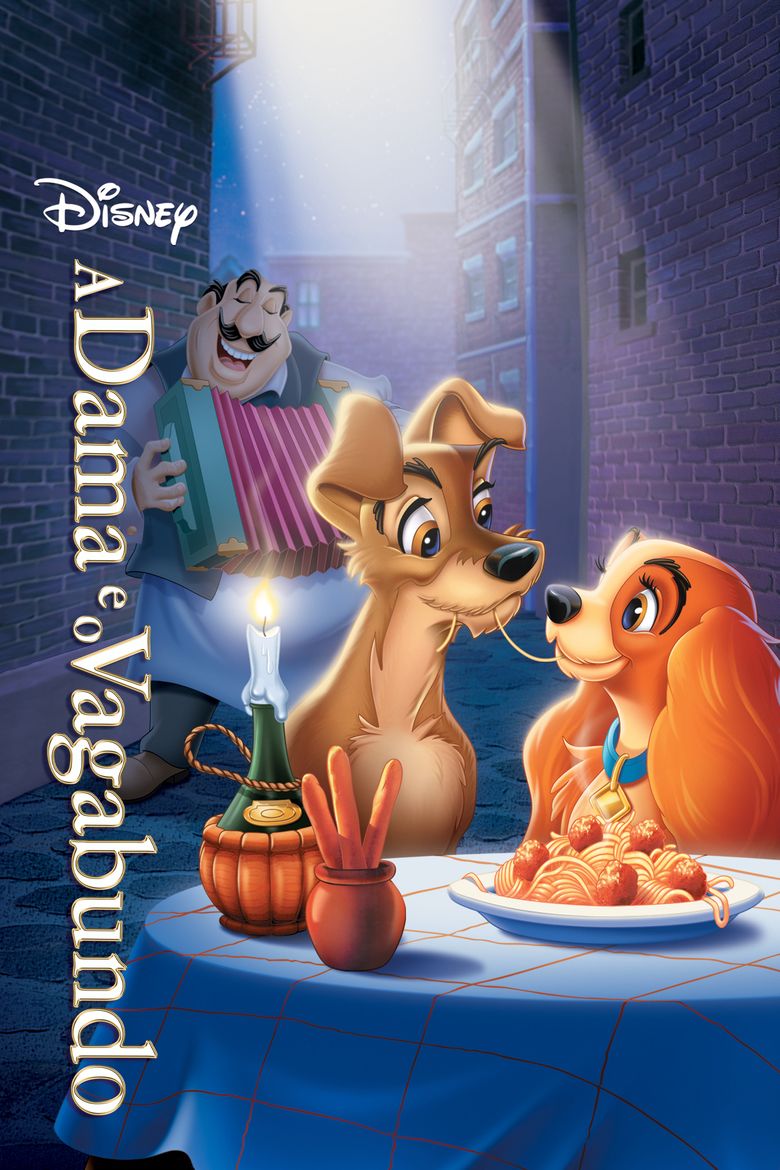 | ||||||||||||||||||||||||||||||||||
Director Clyde GeronimiWilfred JacksonHamilton Luske Release date June 22, 1955 (1955-06-22) Based on Happy Dan, The Whistling Dog by Ward Greene Writer Ward Greene (from the story by), Erdman Penner (story), Joe Rinaldi (story), Ralph Wright (story), Don DaGradi (story) Directors Clyde Geronimi, Wilfred Jackson, Hamilton Luske Songs Lady Cast Peggy Lee (Darling / Si / Am / Peg (voice)), Barbara Luddy (Lady (voice)), Larry Roberts (Tramp (voice)), Bill Thompson (Jock / Bull / Policeman at Zoo / Dachsie / Joe (voice)), Bill Baucom (Trusty (voice)), Stan Freberg (Beaver (voice))Tagline She's from the leash and license set... he's footloose and collar free! Similar One Hundred and One Dalmatians, The Aristocats, Peter Pan (1953 film) | ||||||||||||||||||||||||||||||||||
original 1955 lady and the tramp trailer
Lady and the Tramp is a 1955 American animated romantic musical comedy-drama film produced by Walt Disney and released to theaters on June 22, 1955 by Buena Vista Distribution. The 15th Disney animated feature film, it was the first animated feature filmed in the CinemaScope widescreen film process. Based on Happy Dan, The Whistling Dog by Ward Greene, Lady and the Tramp tells the story of a female American Cocker Spaniel named Lady who lives with a refined, upper-middle-class family, and a male stray mongrel called the Tramp. When the two dogs meet, they embark on many romantic adventures. A direct-to-video sequel, Lady and the Tramp II: Scamp's Adventure, was released in 2001.
Contents
- original 1955 lady and the tramp trailer
- Lady and the tramp bella notte famous spaghetti scene
- Plot
- Cast
- Story development
- Animation
- CinemaScope
- Release
- Home media
- Critical reception
- Accolades
- Music
- Sequel
- References

Lady and the tramp bella notte famous spaghetti scene
Plot

On Christmas morning, 1909, in a quaint Midwestern town, Jim Dear gives his wife Darling an American cocker spaniel puppy that she names Lady. Lady enjoys a happy life with the couple and befriends two local neighborhood dogs, Jock, a Scottish terrier, and Trusty, a bloodhound. Meanwhile, across town, a stray mongrel called the Tramp lives on his own, dining on scraps from Tony's Italian restaurant and protecting his fellow strays Peg (a Pekingese) and Bull (a bulldog) from the local dogcatcher. One day, Lady is saddened after her owners begin treating her rather coldly. Jock and Trusty visit her and determine that their change in behavior is due to Darling expecting a baby. While Jock and Trusty try to explain what a baby is, Tramp interrupts the conversation and offers his own thoughts on the matter, making Jock and Trusty take an immediate dislike to the stray and order him out of the yard. As Tramp leaves, he reminds Lady that "when the baby moves in, the dog moves out."
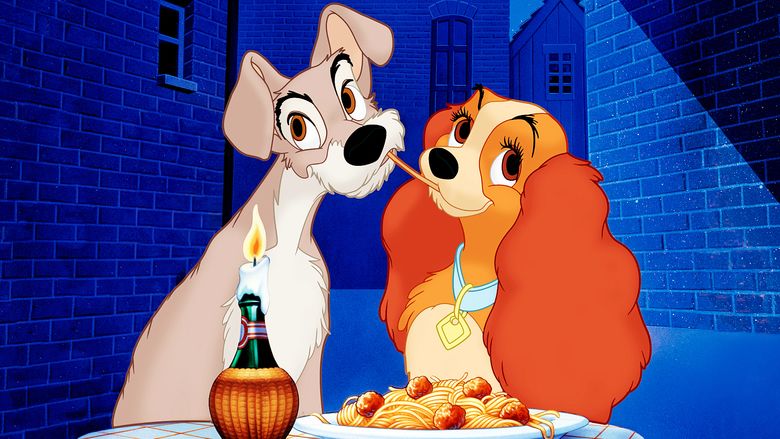
Eventually, the baby arrives and the couple introduces Lady to the infant, of whom Lady grows fond. Soon after, Jim Dear and Darling leave for a trip, with their Aunt Sarah looking after the baby and the house. Aunt Sarah's two trouble-making Siamese cats, Si and Am, deliberately mess up the house and trick her into thinking that Lady attacked them. Aunt Sarah then takes Lady to a pet shop to get a muzzle. Terrifed, Lady flees, only to be pursued by a trio of stray dogs. Tramp rescues her and finds a beaver at the local zoo who can remove the muzzle. Later, Tramp shows Lady how he lives "footloose and collar-free", eventually leading into a candlelit dinner at Tony's. Lady begins to fall in love with Tramp, but she chooses to return home in order to watch over the baby. Tramp offers to escort Lady back home, but when Tramp decides to chase hens around a farmyard for fun, Lady is captured by the dog catcher and brought to the local dog pound. While at the pound, the other dogs (including Peg and Bull, who have been caught) reveal to Lady that Tramp previously had multiple girlfriends and feel it is unlikely he will ever settle down. She is eventually claimed by Aunt Sarah, who chains her in the backyard as punishment for running away.
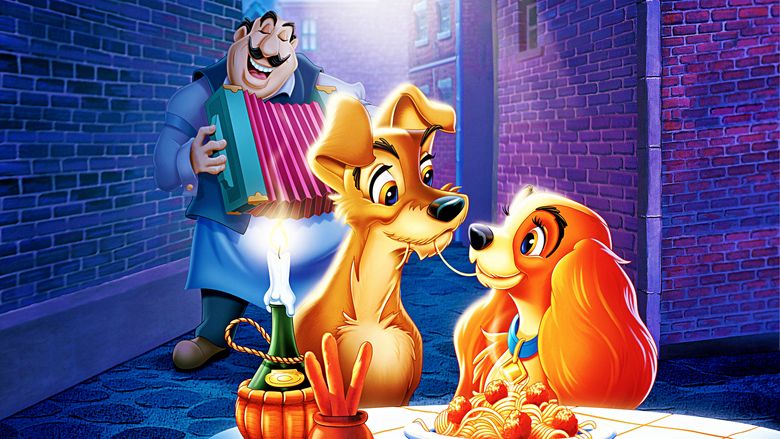
Jock and Trusty visit to comfort Lady, but when Tramp arrives to apologize, Lady angrily confronts him about his past girlfriends and failure to rescue her from the pound. Tramp sadly leaves, but immediately thereafter a rat sneaks into the house. Lady sees the rat and barks frantically at it, but Aunt Sarah tells her to be quiet. Tramp hears her barking and rushes back, entering the house and cornering the rat in the nursery. Lady breaks free and rushes to the nursery, where Tramp inadvertently knocks over the baby's crib before ultimately killing the rat. The commotion alerts Aunt Sarah, who sees both dogs and thinks they are responsible. She pushes Tramp in a closet and locks Lady in the basement, then calls the pound to take Tramp away. Jim Dear and Darling return home as the dog catcher departs, and when they release Lady, she leads them to the dead rat. Overhearing everything, Jock and Trusty chase after the dog catcher's wagon. The dogs are able to track down the wagon and scare the horses, causing the wagon to crash. Jim Dear arrives in a taxi with Lady, and she reunites with Tramp, but their joy is short-lived when they find Trusty pinned underneath the wagon's wheel, motionless, with Jock howling mournfully.
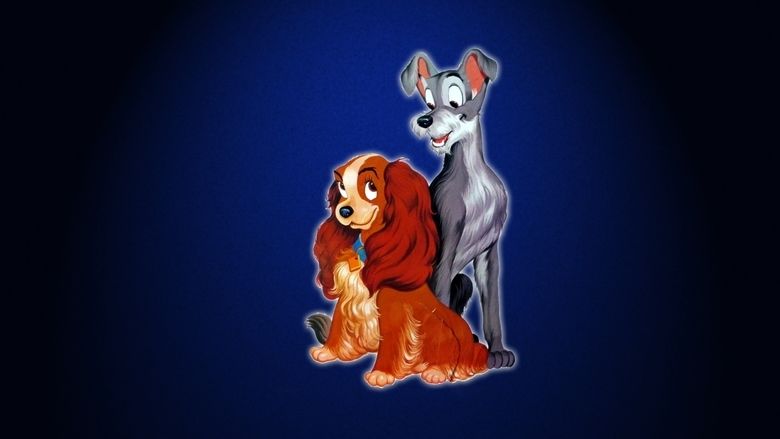
That Christmas, Tramp has been adopted into the family, and he and Lady have started their own family, with three daughters who look like Lady and a son who looks similar to Tramp. Jock comes to see the family along with Trusty, who is still alive and merely suffered a broken leg, which is still healing. Thanks to the puppies, Trusty has a fresh audience for his old stories about his Grandpappy Old Reliable, but he has forgotten them.
Cast

Story development
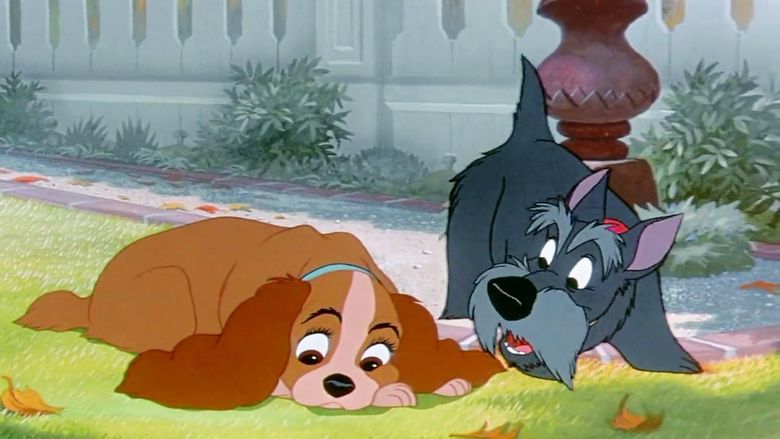
In 1937, Disney story man Joe Grant came up with an idea inspired by the antics of his English Springer Spaniel Lady, and how she got "shoved aside" by Joe's new baby. He approached Walt Disney with sketches of Lady. Disney enjoyed the sketches and commissioned Grant to start story development on a new animated feature entitled Lady. Through the late 1930s and early 1940s, Joe Grant and other artists worked on the story, taking a variety of approaches, but Disney was not pleased with any of them, primarily because he thought Lady was too sweet, and there was not enough action.
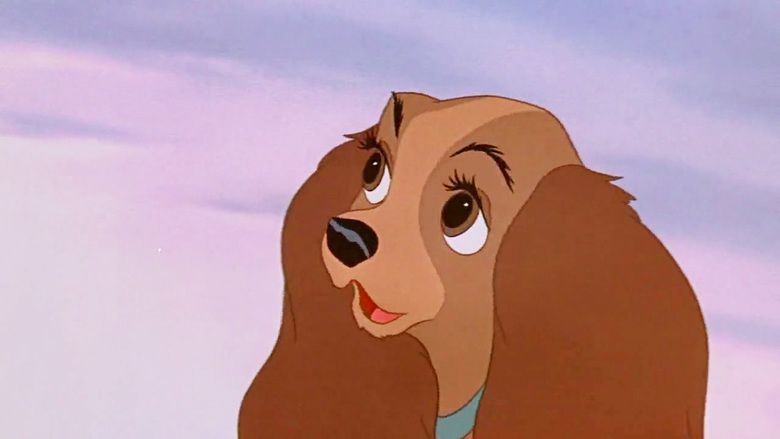
In the early 1940s, Walt read the short story written by Ward Greene, "Happy Dan, The Whistling Dog", in Cosmopolitan magazine. He thought Grant's story would be improved if Lady fell in love with a cynical dog character like the one in Greene's story and bought the rights to it. The cynical dog had various names during development, including Homer, Rags, and Bozo, before "Tramp" was chosen.
The finished film is slightly different from what was originally planned. Lady was to have only one next-door neighbor, a Ralph Bellamy-type canine named Hubert. Hubert was later replaced by Jock and Trusty. Aunt Sarah was the traditional overbearing mother-in-law. In the final film, she is softened to a busybody. Aunt Sarah's Nip and Tuck were later renamed Si and Am. Originally, Lady's owners were called Jim Brown and Elizabeth. These were changed to highlight Lady's point of view. They were briefly referred to as "Mister" and "Missis" before settling on the names "Jim Dear" and "Darling". To maintain a dog's perspective, Darling and Jim's faces are rarely shown, similar to Mammy Two Shoes in the Tom and Jerry cartoons. The rat was a somewhat comic character in early sketches, but became a great deal more frightening, due to the need to raise dramatic tension. A scene created but then deleted was one in which after Trusty says "Everybody knows, a dog's best friend is his human", Tramp describes a world in which the roles of both dogs and humans are switched; the dogs are the masters and vice versa. There was a love triangle among Lady, Tramp, and a Russian wolfhound named Boris (who appears in the dog pound in the final version).
The film's opening sequence, in which Darling unwraps a hat box on Christmas morning and finds Lady inside, is inspired by an incident when Walt Disney presented his wife Lily with a Chow puppy as a gift in a hat box.
In 1949, Grant left the studio, yet Disney story men were continually pulling Grant's original drawings and story off the shelf to retool. A solid story began taking shape in 1953, based on Grant's storyboards and Greene's short story. Greene later wrote a novelization of the film that was released two years before the film itself, at Walt Disney's insistence, so that audiences would be familiar with the story. Grant did not receive film credit for his story work, an issue that animation director Eric Goldberg hoped to rectify in the Lady and the Tramp Platinum Edition's behind-the-scenes vignette that explained Grant's role.
Singer Peggy Lee not only voiced four characters but co-wrote six songs for the movie.
Animation
As they had done with deer on Bambi, the animators studied many dogs of different breeds to capture the movement and personality of dogs. Although the spaghetti eating sequence is probably now the best known scene from the film, Walt Disney was prepared to cut it, thinking that it would not be romantic and that dogs eating spaghetti would look silly. Animator Frank Thomas was against Walt's decision and animated the entire scene himself without any lay-outs. Walt was impressed by Thomas's work and how he romanticized the scene and kept the scene in. On viewing the first take of the scene, the animators felt that the action should be slowed down, so an apprentice trainee was assigned to create "half numbers" in between many of the original frames.
Originally, the background artist was supposed to be Mary Blair and she did some inspirational sketches for the film. However, she left the studio to become a children's book illustrator in 1953. Claude Coats was then appointed as the key background artist. Coats made models of the interiors of Jim Dear and Darling's house, and shot photos and film at a low perspective as reference to maintain a dog's view. Eyvind Earle (who later became the art director of Disney's Sleeping Beauty) did almost 50 miniature concept sketches for the Bella Notte sequence and was a key contributor to the film.
CinemaScope
Originally, Lady and the Tramp was planned to be filmed in a regular full frame aspect ratio. However, due to the growing interest of widescreen film among movie-goers, Disney decided to animate the film in CinemaScope making Lady and the Tramp the first animated feature filmed in the process. This new innovation presented additional problems for the animators: the expansion of space created more realism but gave fewer closeups. It also made it difficult for a single character to dominate the screen so that groups had to be spread out to keep the screen from appearing sparse. Longer takes become necessary since constant jump-cutting would seem too busy or annoying. Layout artists essentially had to reinvent their technique. Animators had to remember that they had to move their characters across a background instead of the background passing behind them. Yet the animators overcame these obstacles during the action scenes, such as Tramp killing the rat.
More problems arose as the premiere date got closer since not all theaters had the capability to show CinemaScope at the time. Upon learning this, Walt issued two versions of the film: one in widescreen, and another in the Academy ratio. This involved gathering the layout artists to restructure key scenes when characters were on the edges of the screen.
Release
Lady and the Tramp was originally released to theaters on June 22, 1955. At the time, the film took in a higher figure than any other Disney animated feature since Snow White and the Seven Dwarfs, earning an estimated $7.5 million in rentals at the North American box office in 1955. An episode of Disneyland called "A Story of Dogs" aired before the film's release. The film was also reissued to theaters in 1962, 1972, 1980, and 1986. Lady and the Tramp also played a limited engagement in select Cinemark Theatres from February 16–18, 2013.
Home media
Lady and the Tramp was first released on North American VHS and Laserdisc in 1987 as part of the Walt Disney Classics video series and in the UK in 1990. It was released on VHS in 1998 as part of the Walt Disney Masterpiece Collection video series. A Disney Limited Issue series DVD of the film was released on November 23, 1999.
After the first release on video tapes, Peggy Lee sought performance and song royalties on the video sales. Disney CEO Eisner refused, thus she filed suite in 1988. Eventually in 1992, the California Court of Appeals order Disney to pay Lee $3.2 million in compensation or about a 4% on the video sales.
Lady and the Tramp was remastered and restored for DVD on February 28, 2006, as the seventh installment of Disney's Platinum Editions series. One million copies of the Platinum Edition were sold on February 28, 2006. The Platinum Edition DVD went on moratorium on January 31, 2007, along with the 2006 DVD reissue of the film's sequel Lady and the Tramp II: Scamp's Adventure.
Lady and the Tramp was released on Blu-ray on February 7, 2012 as a part of Disney's Diamond Editions series. A standalone 1-disc DVD edition was released on March 20, 2012.
Critical reception
Despite being an enormous success at the box office, the film was also initially panned by critics: one indicated that the dogs had "the dimensions of hippos," another that "the artists' work is below par".
However, the film has since gone on to become regarded as a classic. The sequence of Lady and Tramp sharing a plate of spaghetti — climaxed by an accidental kiss as they swallow opposite ends of the same strand of spaghetti — is considered an iconic scene in American film history.
Lady and the Tramp was named number 95 out of the "100 Greatest Love Stories of All Time" by the American Film Institute in their 100 Years...100 Passions special, as one of only two animated films to appear on the list, along with Disney's Beauty and the Beast which ranked 34th. In 2010, Rhapsody called its accompanying soundtrack one of the all-time great Disney & Pixar soundtracks. In June 2011, TIME named it one of "The 25 All-TIME Best Animated Films".
The review aggregator website Rotten Tomatoes reported that the film received an 89% approval rating with an average rating of 7.6/10 based on 38 reviews. The website's consensus states that "A nostalgic charmer, Lady and the Tramp's token sweetness is mighty but the songs and richly colored animation are technically superb and make for a memorable experience."
Accolades
Music
The score for the film was composed and conducted by Oliver Wallace. Recording artist Peggy Lee wrote the songs with Sonny Burke and assisted with the score as well. In the film, she sings "La La Lu", "The Siamese Cat Song", and "He's a Tramp". She helped promote the film on the Disney TV series, explaining her work with the score and singing a few of the film's numbers. These appearances are available as part of the Lady and the Tramp Platinum Edition DVD set.
On November 16, 1988, Peggy Lee sued the Walt Disney Company for breach of contract, claiming that she retained the rights to transcriptions of the music, arguing that videotape editions were transcriptions. After a protracted legal battle, she was awarded $2.3 million in 1991.
The remastered soundtrack of Lady and the Tramp was released on CD by Walt Disney Records on September 9, 1997, and was released as a digital download on September 26, 2006.
Sequel
On February 27, 2001, Disney Television Animation released a direct-to-video sequel to the film entitled Lady and the Tramp II: Scamp's Adventure. Produced 46 years after its predecessor, the film centers on the adventures of Lady and Tramp's only son, Scamp, who desires to be a wild dog. He runs away from his family and joins a gang of junkyard dogs to fulfill his longing for freedom and a life without rules. Reviews for the sequel were generally mixed to negative, with critics panning its plot.
References
Lady and the Tramp WikipediaLady and the Tramp IMDbLady and the Tramp Rotten TomatoesLady and the Tramp themoviedb.org
